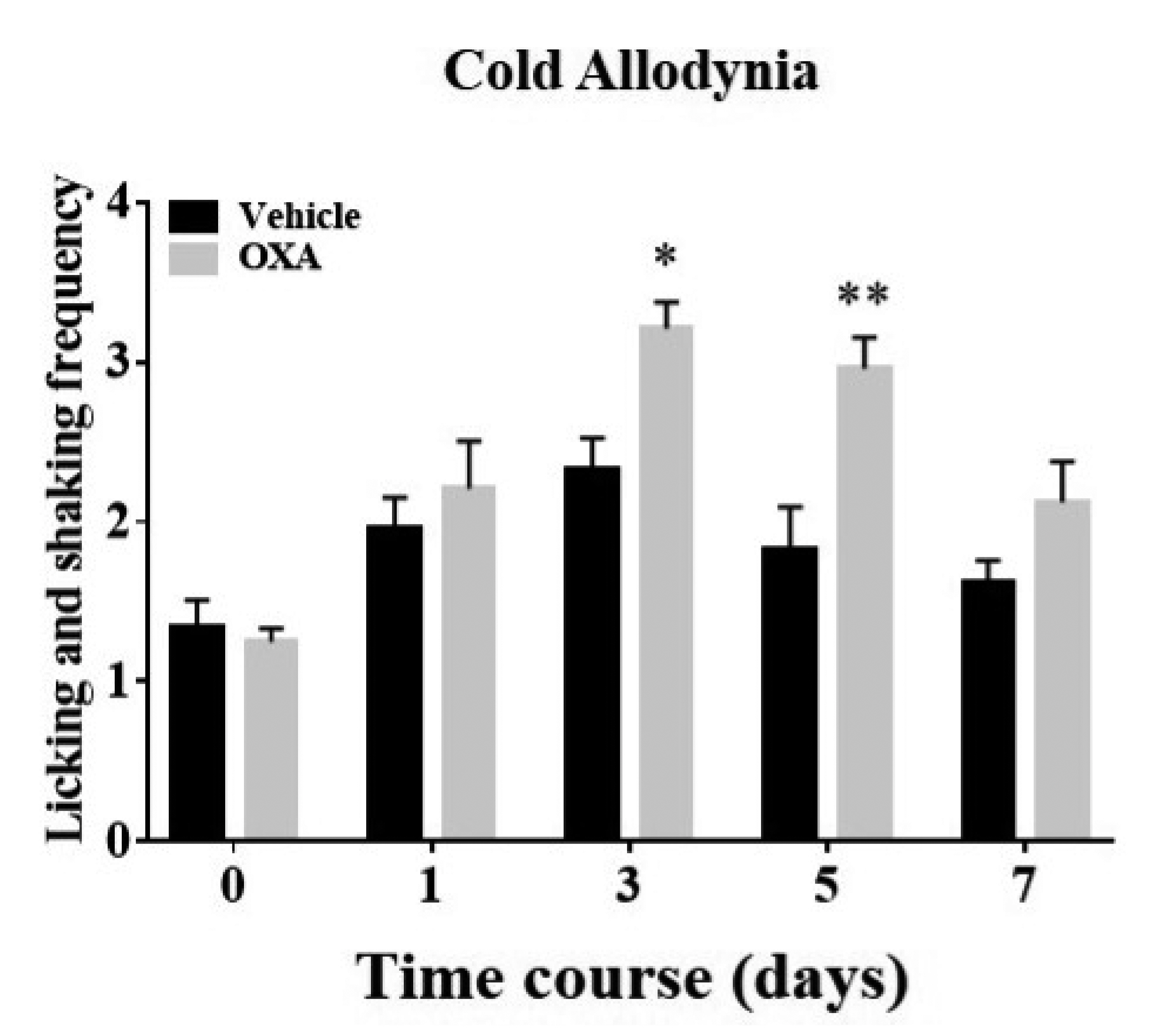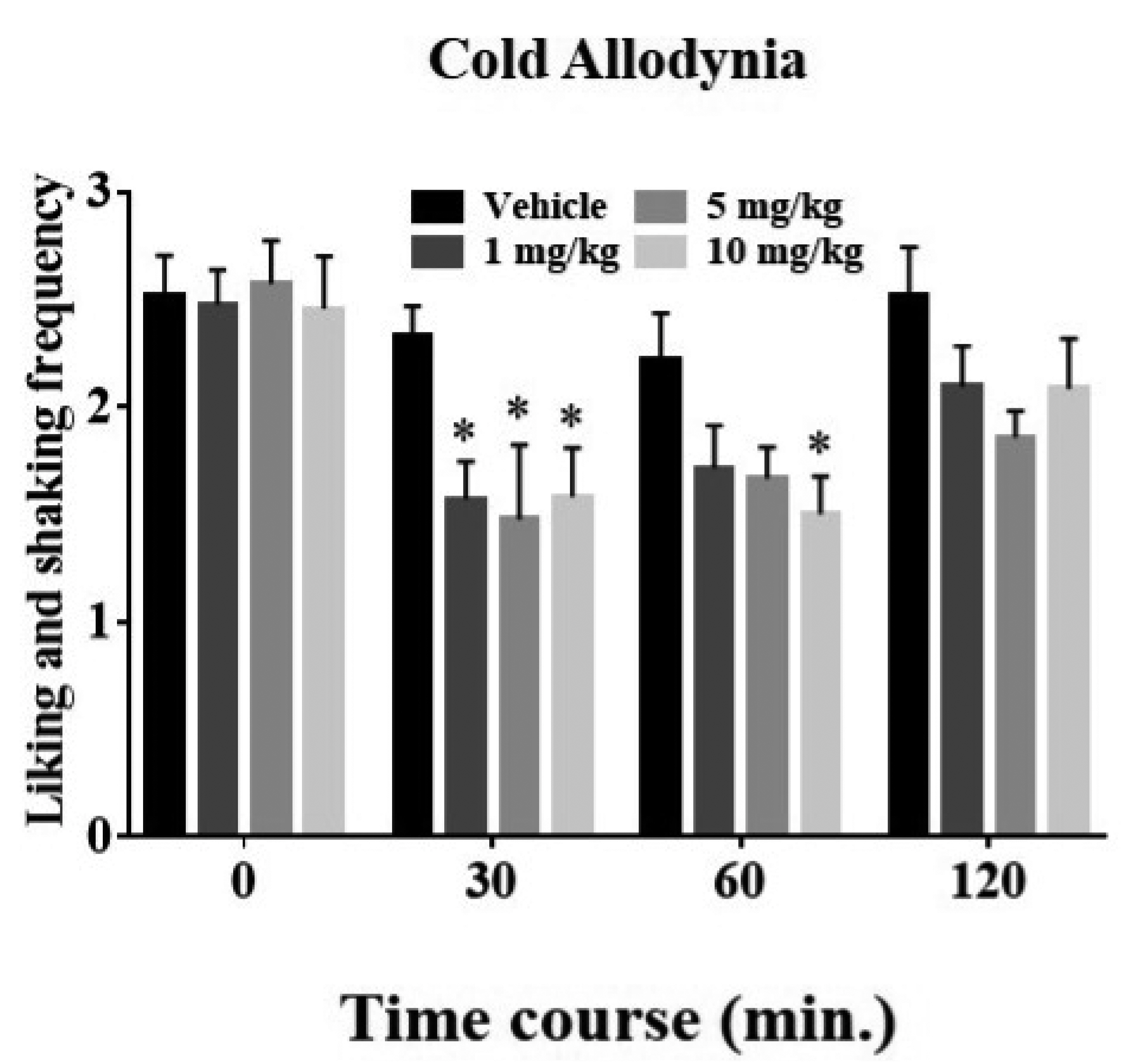Korean J Physiol Pharmacol.
2021 Sep;25(5):489-494. 10.4196/kjpp.2021.25.5.489.
5-HT 1A receptors mediate the analgesic effect of rosavin in a mouse model of oxaliplatin-induced peripheral neuropathic pain
- Affiliations
-
- 1Department of Physiology, College of Korean Medicine, Kyung Hee University, Seoul 02447, Korea.
- 2Department of Anesthesiology, Xuan Wu Hospital, Capital Medical University, Beijing 100053, China.
- 3Department of Korean Medicine, Graduate School, Kyung Hee University, Seoul 02447, Korea.
- 4Department of East-West Medicine, Graduate School, Kyung Hee University, Seoul 02447, Korea.
- 5Department of Life and Nanopharmaceutical Science, Graduate School, Kyung Hee University, Seoul 02447, Korea.
- KMID: 2519411
- DOI: http://doi.org/10.4196/kjpp.2021.25.5.489
Abstract
- Oxaliplatin, a third-generation platinum derivative, is the mainstay of current antineoplastic medications for advanced colorectal cancer therapy. However, peripheral neuropathic complications, especially cold allodynia, undermine the lifeprolonging outcome of this anti-cancer agent. Rosavin, a phenylpropanoid derived originally from Rhodiola rosea, exhibits a wide range of therapeutic properties. The present study explored whether and how rosavin alleviates oxaliplatin-induced cold hypersensitivity in mice. In the acetone drop test, cold allodynia behavior was observed from days 3 to 5 after a single injection of oxaliplatin (6 mg/kg, i.p.). Cold allodynia was significantly attenuated following rosavin treatment (10 mg/kg, i.p.). Specific endogenous 5-HT depletion by three consecutive pretreatments with parachlorophenylalanine (150 mg/kg/day, i.p.) abolished the analgesic action of rosavin; this effect was not observed following pretreatment with naloxone (opioid receptor antagonist, 10 mg/kg, i.p.). Furthermore, 5-HT1A receptor antagonist WAY-100635 (0.16 mg/kg, i.p.), but not 5-HT3 receptor antagonist MDL-72222 (1 mg/kg, i.p.), blocked rosavin-induced analgesia. These results suggest that rosavin may provide a novel approach to alleviate oxaliplatin-induced cold allodynia by recruiting the activity of 5-HT1A receptors.
Figure
Reference
-
1. Zajączkowska R, Kocot-Kępska M, Leppert W, Wrzosek A, Mika J, Wordliczek J. 2019; Mechanisms of chemotherapy-induced peripheral neuropathy. Int J Mol Sci. 20:1451. DOI: 10.3390/ijms20061451. PMID: 30909387. PMCID: PMC6471666.
Article2. Boyette-Davis JA, Hou S, Abdi S, Dougherty PM. 2018; An updated understanding of the mechanisms involved in chemotherapy-induced neuropathy. Pain Manag. 8:363–375. DOI: 10.2217/pmt-2018-0020. PMID: 30212277. PMCID: PMC6462837.
Article3. Starobova H, Vetter I. 2017; Pathophysiology of chemotherapy-induced peripheral neuropathy. Front Mol Neurosci. 10:174. DOI: 10.3389/fnmol.2017.00174. PMID: 28620280. PMCID: PMC5450696.
Article4. Kerckhove N, Collin A, Condé S, Chaleteix C, Pezet D, Balayssac D. 2017; Long-term effects, pathophysiological mechanisms, and risk factors of chemotherapy-induced peripheral neuropathies: a comprehensive literature review. Front Pharmacol. 8:86. DOI: 10.3389/fphar.2017.00086. PMID: 28286483. PMCID: PMC5323411.
Article5. Choi HM, Jung Y, Park J, Kim HL, Youn DH, Kang J, Jeong MY, Lee JH, Yang WM, Lee SG, Ahn KS, Um JY. 2016; Cinnamomi cortex (Cinnamomum verum) suppresses testosterone-induced benign prostatic hyperplasia by regulating 5α-reductase. Sci Rep. 6:31906. DOI: 10.1038/srep31906. PMID: 27549514. PMCID: PMC4994048.
Article6. Hayashi K, Imanishi N, Kashiwayama Y, Kawano A, Terasawa K, Shimada Y, Ochiai H. 2007; Inhibitory effect of cinnamaldehyde, derived from Cinnamomi cortex, on the growth of influenza A/PR/8 virus in vitro and in vivo. Antiviral Res. 74:1–8. DOI: 10.1016/j.antiviral.2007.01.003. PMID: 17303260.
Article7. Chae HK, Kim W, Kim SK. 2019; Phytochemicals of Cinnamomi Cortex: cinnamic acid, but not cinnamaldehyde, attenuates oxaliplatin-induced cold and mechanical hypersensitivity in rats. Nutrients. 11:432. DOI: 10.3390/nu11020432. PMID: 30791474. PMCID: PMC6412559.
Article8. Kim C, Lee JH, Kim W, Li D, Kim Y, Lee K, Kim SK. 2016; The suppressive effects of Cinnamomi Cortex and its phytocompound coumarin on oxaliplatin-induced neuropathic cold allodynia in rats. Molecules. 21:1253. DOI: 10.3390/molecules21091253. PMID: 27657030. PMCID: PMC6274362.
Article9. Perfumi M, Mattioli L. 2007; Adaptogenic and central nervous system effects of single doses of 3% rosavin and 1% salidroside Rhodiola rosea L. extract in mice. Phytother Res. 21:37–43. DOI: 10.1002/ptr.2013. PMID: 17072830.10. Chiang HM, Chen HC, Wu CS, Wu PY, Wen KC. 2015; Rhodiola plants: chemistry and biological activity. J Food Drug Anal. 23:359–369. DOI: 10.1016/j.jfda.2015.04.007. PMID: 28911692.
Article11. Park JS, Choi J, Kwon JY, Jung KA, Yang CW, Park SH, Cho ML. 2018; A probiotic complex, rosavin, zinc, and prebiotics ameliorate intestinal inflammation in an acute colitis mouse model. J Transl Med. 16:37. DOI: 10.1186/s12967-018-1410-1. PMID: 29466999. PMCID: PMC5822606.
Article12. Panossian AG, Efferth T, Shikov AN, Pozharitskaya ON, Kuchta K, Mukherjee PK, Banerjee S, Heinrich M, Wu W, Guo DA, Wagner H. 2021; Evolution of the adaptogenic concept from traditional use to medical systems: pharmacology of stress- and aging-related diseases. Med Res Rev. 41:630–703. DOI: 10.1002/med.21743. PMID: 33103257. PMCID: PMC7756641.
Article13. Stancheva SL, Mosharrof A. 1987; Effect of the extract of Rhodiola rosea L. on the content of the brain biogenic monamines. Med Physiol. 40:85–87.14. Chen QG, Zeng YS, Qu ZQ, Tang JY, Qin YJ, Chung P, Wong R, Hägg U. 2009; The effects of Rhodiola rosea extract on 5-HT level, cell proliferation and quantity of neurons at cerebral hippocampus of depressive rats. Phytomedicine. 16:830–838. DOI: 10.1016/j.phymed.2009.03.011. PMID: 19403286.
Article15. Lishmanov IuB, Trifonova ZhV, Tsibin AN, Maslova LV, Dement'eva LA. 1987; Plasma beta-endorphin and stress hormones in stress and adaptation. Biull Eksp Biol Med. 103:422–424. Russian. DOI: 10.1007/BF00842472. PMID: 2952180.16. Montiel-Ruiz RM, González-Trujano ME, Déciga-Campos M. 2013; Synergistic interactions between the antinociceptive effect of Rhodiola rosea extract and B vitamins in the mouse formalin test. Phytomedicine. 20:1280–1287. DOI: 10.1016/j.phymed.2013.07.006. PMID: 23920277.
Article17. Millan MJ. 2002; Descending control of pain. Prog Neurobiol. 66:355–474. DOI: 10.1016/S0301-0082(02)00009-6. PMID: 12034378.
Article18. Nguyen LM, Rhondali W, De la Cruz M, Hui D, Palmer L, Kang DH, Parsons HA, Bruera E. 2013; Frequency and predictors of patient deviation from prescribed opioids and barriers to opioid pain management in patients with advanced cancer. J Pain Symptom Manage. 45:506–516. DOI: 10.1016/j.jpainsymman.2012.02.023. PMID: 22940562. PMCID: PMC3856203.
Article19. Zimmermann M. 1983; Ethical guidelines for investigations of experimental pain in conscious animals. Pain. 16:109–110. DOI: 10.1016/0304-3959(83)90201-4. PMID: 6877845.
Article20. Li D, Lee JH, Choi CW, Kim J, Kim SK, Kim W. 2019; The analgesic effect of venlafaxine and its mechanism on oxaliplatin-induced neuropathic pain in mice. Int J Mol Sci. 20:1652. DOI: 10.3390/ijms20071652. PMID: 30987090. PMCID: PMC6479607.
Article21. Li D, Lee Y, Kim W, Lee K, Bae H, Kim SK. 2015; Analgesic effects of Bee Venom derived phospholipase A2 in a mouse model of oxaliplatin-induced neuropathic pain. Toxins (Basel). 7:2422–2434. DOI: 10.3390/toxins7072422. PMID: 26131771. PMCID: PMC4516921.22. Li D, Chung G, Kim SK. 2020; The involvement of central noradrenergic pathway in the analgesic effect of bee venom acupuncture on vincristine-induced peripheral neuropathy in rats. Toxins (Basel). 12:775. DOI: 10.3390/toxins12120775. PMID: 33291335. PMCID: PMC7762247.
Article23. Nakagawa T, Minami M, Katsumata S, Ienaga Y, Satoh M. 1995; Suppression of naloxone-precipitated withdrawal jumps in morphine-dependent mice by stimulation of prostaglandin EP3 receptor. Br J Pharmacol. 116:2661–2666. DOI: 10.1111/j.1476-5381.1995.tb17223.x. PMID: 8590986. PMCID: PMC1909143.24. Choi S, Chae HK, Heo H, Hahm DH, Kim W, Kim SK. 2019; Analgesic effect of melittin on oxaliplatin-induced peripheral neuropathy in rats. Toxins (Basel). 11:396. DOI: 10.3390/toxins11070396. PMID: 31288453. PMCID: PMC6669583.
Article25. Sung SH, Kim JW, Han JE, Shin BC, Park JK, Lee G. 2021; Animal venom for medical usage in pharmacopuncture in Korean medicine: current status and clinical implication. Toxins (Basel). 13:105. DOI: 10.3390/toxins13020105. PMID: 33535603. PMCID: PMC7912904.
Article26. Kwon JY, Lee SH, Jhun J, Choi J, Jung K, Cho KH, Kim SJ, Yang CW, Park SH, Cho ML. 2018; The combination of probiotic complex, rosavin, and zinc improves pain and cartilage destruction in an osteoarthritis rat model. J Med Food. 21:364–371. DOI: 10.1089/jmf.2017.4034. PMID: 29346012.
Article27. Déciga-Campos M, González-Trujano ME, Ventura-Martínez R, Montiel-Ruiz RM, Ángeles-López GE, Brindis F. 2016; Antihyperalgesic activity of Rhodiola rosea in a diabetic rat model. Drug Dev Res. 77:29–36. DOI: 10.1002/ddr.21289. PMID: 26763184.28. Polter AM, Li X. 2010; 5-HT1A receptor-regulated signal transduction pathways in brain. Cell Signal. 22:1406–1412. DOI: 10.1016/j.cellsig.2010.03.019. PMID: 20363322. PMCID: PMC2903656.
Article29. Otoshi CK, Walwyn WM, Tillakaratne NJ, Zhong H, Roy RR, Edgerton VR. 2009; Distribution and localization of 5-HT1A receptors in the rat lumbar spinal cord after transection and deafferentation. J Neurotrauma. 26:575–584. DOI: 10.1089/neu.2008.0640. PMID: 19260781. PMCID: PMC2828940.30. Oyama T, Ueda M, Kuraishi Y, Akaike A, Satoh M. 1996; Dual effect of serotonin on formalin-induced nociception in the rat spinal cord. Neurosci Res. 25:129–135. DOI: 10.1016/0168-0102(96)01034-6. PMID: 8829149.
Article31. Lee JH, Min D, Lee D, Kim W. 2021; Zingiber officinale roscoe rhizomes attenuate oxaliplatin-induced neuropathic pain in mice. Molecules. 26:548. DOI: 10.3390/molecules26030548. PMID: 33494465. PMCID: PMC7866215.32. Liu Z, Li X, Simoneau AR, Jafari M, Zi X. 2012; Rhodiola rosea extracts and salidroside decrease the growth of bladder cancer cell lines via inhibition of the mTOR pathway and induction of autophagy. Mol Carcinog. 51:257–267. DOI: 10.1002/mc.20780. PMID: 21520297. PMCID: PMC3144985.
Article33. Udintsev SN, Shakhov VP. 1989; Decrease in the growth rate of Ehrlich's tumor and Pliss' lymphosarcoma with partial hepatectomy. Vopr Onkol. 35:1072–1075. Russian.
- Full Text Links
- Actions
-
Cited
- CITED
-
- Close
- Share
- Similar articles
-
- Involvement of spinal muscarinic and serotonergic receptors in the anti-allodynic effect of electroacupuncture in rats with oxaliplatin-induced neuropathic pain
- Analgesic Effect of Auricular Vagus Nerve Stimulation on Oxaliplatin-induced Peripheral Neuropathic Pain in a Rodent Model
- The Combined Antiallodynic Effect of Gabapentin and Milnacipran in a Rat Neuropathic Pain Model
- Multiple 5-Hydroxytryptamine (5-HT) Receptors Are Involved in the Melittin-induced Nociceptive Responses in Rat I. Role of Peripheral 5-HT Receptor
- Effects of Clonidine and Yohimbine on Neuropathic Pain in a Rat Model





